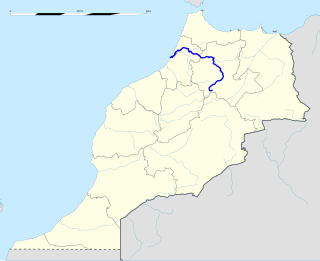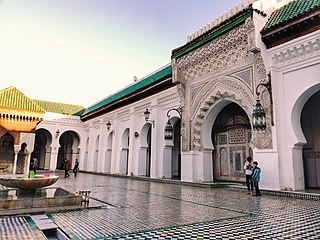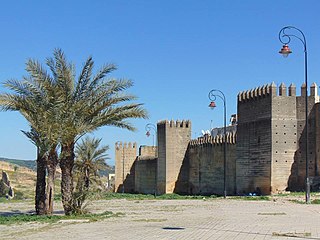
Leather is a strong, flexible and durable material obtained from the tanning, or chemical treatment, of animal skins and hides to prevent decay. The most common leathers come from cattle, sheep, goats, equine animals, buffalo, pigs and hogs, and aquatic animals such as seals and alligators.

Tanning, or hide tanning, is the process of treating skins and hides of animals to produce leather. A tannery is the place where the skins are processed.

The Sebou is a river in northern Morocco. At its source in the Middle Atlas mountains it is known as the Guigou River. The river is 496 kilometers long and has an average water flow of 137 m3/s, which makes it the largest North African river by volume. It passes near Fes, the second largest city in Morocco, and discharges to the Atlantic Ocean at Mehdya. Sebou is navigable for only 16 km as far as the city of Kenitra, which has the only river port in Morocco. Its most important tributaries are the Ouergha River, Baht River and Inaouen River. The river supports irrigation in Morocco's most fertile region: the Gharb.

Ostrich leather is the result of tanning skins taken from African ostriches farmed for their feathers, skin and meat. The leather is distinctive for its pattern of vacant quill follicles, forming bumps ranged across a smooth field in varying densities. It requires an intricate, specialised, and expensive production process making its aesthetic value costly.

Fes el Bali is the oldest walled part of Fez, the second largest city of Morocco. Fes el Bali was founded as the capital of the Idrisid dynasty between 789 and 808 AD. UNESCO listed Fes el Bali, along with Fes Jdid, as a World Heritage Site in 1981 under the name Medina of Fez. The World Heritage Site includes Fes el Bali's urban fabric and walls as well as a buffer zone outside of the walls that is intended to preserve the visual integrity of the location. Fes el Bali is, along with Fes Jdid and the French-created Ville Nouvelle or “New Town”, one of the three main districts in Fez.

Fes Jdid or Fes el-Jdid is one of the three parts of Fez, the second largest city of Morocco. It was founded by the Marinids in 1276 as an extension of Fes el Bali and as a royal citadel and capital. It is occupied in large part by the historic Royal Palace, which was once the center of government in Morocco and which is still used on occasion by the King of Morocco today. The district also contains the historic Mellah of the city. Since 1981 it has been classified, along with Fes el-Bali, as a UNESCO World Heritage Site.

The leather manufacturing process are the operations taken to create leather from hides. The procedure is divided into three sub-processes: preparatory stages, tanning, and crusting. All true leathers will undergo these sub-processes. A further sub-process, surface coating, may be added into the sequence. The list of operations that leathers undergo vary with the type of leather. There are environmental impacts associated with the process.
Sidi Moussa may refer to:

Fes or Fez is a city in northern inland Morocco and the capital of the Fez-Meknes administrative region. It is one of the largest cities in Morocco, with a population of 1.256 million, according to the 2024 census. Located to the northwest of the Atlas Mountains, it is surrounded by hills and the old city is centered around the Fez River flowing from west to east. Fez has been called the "Mecca of the West" and the "Athens of Africa". It is also considered the spiritual and cultural capital of Morocco.

Bab Bou Jeloud is an ornate city gate in Fes el Bali, the old city of Fez, Morocco. The current gate was built by the French colonial administration in 1913 to serve as the grand entrance to the old city.
Aziza Chaouni is a Moroccan architect who teaches at the University of Toronto.

The Fortifications of Fez comprise a complex circuit of ramparts and gates surrounding Fes el-Bali and Fes el-Jdid, two urban agglomerations that compose the old "medina" of Fes, Morocco. They also include a number of kasbahs (citadels) and forts which were built both to protect and to control the city. These fortifications have been built up over many centuries and the extensive remnants today date from many different periods.

The architecture of Fez, Morocco, reflects the wider trends of Moroccan architecture dating from the city's foundation in the late 8th century and up to modern times. The old city (medina) of Fes, consisting of Fes el-Bali and Fes el-Jdid, is notable for being an exceptionally well-preserved medieval North African city and is classified as a UNESCO World Heritage Site. A large number of historic monuments from different periods still exist in it today, including mosques, madrasas, synagogues, hammams (bathhouses), souqs (markets), funduqs (caravanserais), defensive walls, city gates, historic houses, and palaces.

The Oued Fes or Fez River is a river in Morocco. It is a tributary of the Sebou River and historically the main source of water for Morocco's second largest city, Fes, after which it is named.

The El-Oued Mosque is a mosque in Fes el-Bali, the historic medina of Fes, Morocco. It was built in the late 18th or early 19th century on the site of a former 14th-century madrasa by the same name.

The Funduq al-Shamma'in or Foundouk Chemmaïne is a medieval funduq in Fes, Morocco. It is also directly adjoined by another funduq structure, the Funduq al-Sbitriyyin. Together, the two form a combined architectural complex sometimes referred to as the Funduq Shamma'in-Sbitriyyin. Both are located side by side just west of the al-Qarawiyyin Mosque in the heart of the historic medina, Fes el-Bali.

The Hammam as-Saffarin is a historic hammam (bathhouse) in the medina of Fes, Morocco. It is located on the southwest side of Place Seffarine, across from the Madrasa Saffarin and south of the Qarawiyyin Mosque.

The Mausoleum of Sidi Harazem or Marabout of Sidi Harazem is a funerary monument and shrine in Fez, Morocco. It is located in the Bab Ftouh Cemetery, one of the city's largest historic cemeteries. It contains the tomb of Sidi 'Ali ibn Harazem, a 12th-century Sufi mystic who died in 1164–65.

The Sidi Moussa Tannery or Guerniz Tannery is a historic tanning facility located in the heart of Fes el-Bali, the historic medina of Fez, Morocco. The tannery is located in the Guerniz neighbourhood, near the Zawiya of Moulay Idris II and the Nejjarine Museum.

The History of Fez begins with its foundation by Idris I and Idris II at the end of the 8th century and the beginning of the 9th century CE. It initially consisted of two autonomous and competing settlements on opposing shores of what is now known as the Oued Fes. Initially inhabited by a largely Berber (Amazigh) population, successive waves of mainly Arab immigrants from Ifriqiya (Tunisia) and al-Andalus (Spain/Portugal) over time gave the nascent city an Arab character as well. After the downfall of the Idrisid dynasty, it was contested between different Zenata groups allied with either the Fatimid Caliphate or the Umayyad Caliphate of Cordoba. In the 11th century the Almoravid sultan Yusuf ibn Tashfin conquered the region and united its two settlements into what is today the Fes el-Bali quarter. Under the rule of the Almoravids and of the Almohads after them, despite losing the status of capital to Marrakesh, the city remained the economic and political center of northern Morocco and gained a reputation for religious scholarship and mercantile activity.




















